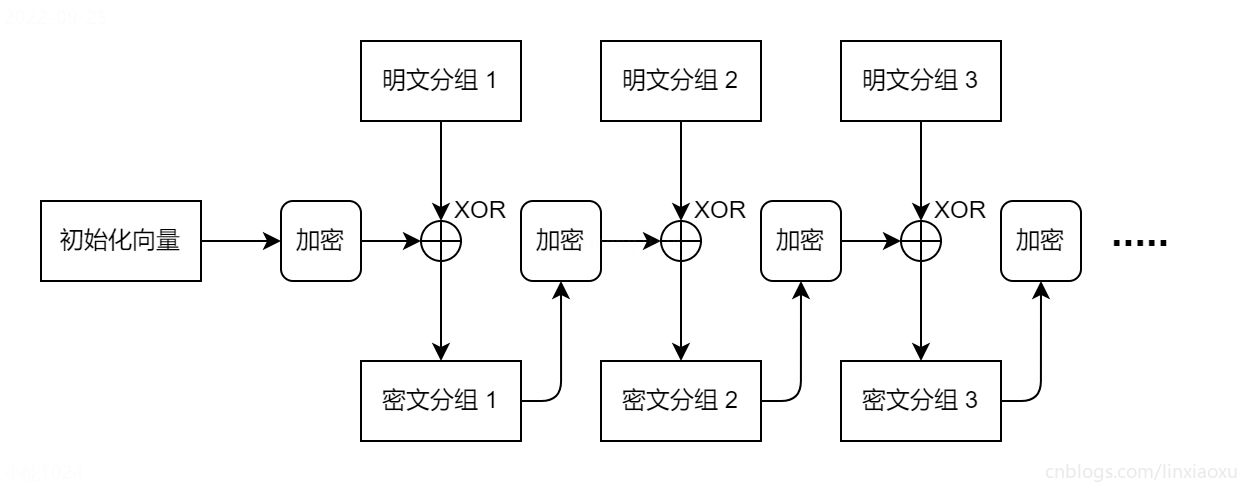密碼學奇妙之旅、01 CFB密文反饋模式、AES標準、Golang程式碼
2022-09-26 06:00:41
CFB密文反饋模式
CFB密文反饋模式屬於分組密碼模式中的一種。加密與解密使用同一結構,加密步驟生成用於互斥或的金鑰流。
其彌補了ECB電子密碼本模式的不足(明文中的重複排列會反映在密文中,通過刪除替換分組可以對明文進行操作)
其優點是
- 不需要填充。因為從明文分組到密文分組只需要一次XOR,使用的是前一次密文分組經過加密演演算法生成的金鑰流。
- 解密支援並行。在已知全部密文分組的情況下,可以對每一部分分組開啟多執行緒進行解密。
- 能夠解密任意密文分組。任意密文分組只與前一個密文分組有關。
其缺點是:
- 加密不支援並行。任意密文分組只與前一個密文分組有關,所以必須按照一定順序從頭到尾加密。
- 當密文分組某個位元出錯時,影響當前明文分組的一個位元位和下一個明文分組的全部位元位。當密文分組發生改變,通過加密演演算法生成的金鑰流完全改變,導致下一個明文分組不可讀。
- 不能抵禦重放攻擊。傳送人連續使用相同金鑰傳送密文,駭客可以將新傳送密文的後部分分組替換為舊密文的後部分分組(混入)。導致接收人收到的訊息重複,且無法正確判斷是通訊錯誤還是人為攻擊(可用訊息鑑別碼判斷)。

程式碼
注:cipher包內建多個分組密碼模式,如 CTR 模式。只需修改建立模式範例的一行程式碼。
PS C:\Users\小能喵喵喵\Desktop\Go\Cryptography\對稱加密\DES_CFB> go run .
獲取不到程式執行附加引數
輸入字串:你好,很高興認識你,這是一段文字。
金鑰: woshimima11451410086123456789012
加密後: gjjhI1e25hqMyMaFfoB+uAc1vb8WnlJzS8S6rKnC9H4VNLMdSuM/P3TR8YUjwYdxGbAZkOsndyaK5z3rT52I7rM2c2rK
解密後: 你好,很高興認識你,這是一段文字。
package main
import (
"bufio"
"crypto/aes"
"crypto/cipher"
"crypto/rand"
"encoding/base64"
"errors"
"fmt"
"io"
"log"
"os"
)
func main() {
cipherKey := []byte("woshimima11451410086123456789012") //32 bit key for AES-256
//cipherKey := []byte("woshimima114514100861234") //24 bit key for AES-192
//cipherKey := []byte("woshimima1145141") //16 bit key for AES-128
reader := bufio.NewReader(os.Stdin)
var message string
// 如果沒有給執行附加引數
if len(os.Args) != 2 {
fmt.Printf("\n\t獲取不到程式執行附加引數\n")
fmt.Printf("\t輸入字串:")
message, _ = reader.ReadString('\n')
} else {
message = os.Args[1]
}
encrypted, err := encrypt(cipherKey, message)
//如果加密失敗
if err != nil {
//列印錯誤資訊
log.Println(err)
os.Exit(-2)
}
//列印金鑰和密文
fmt.Printf("\n\t金鑰: %s\n", string(cipherKey))
fmt.Printf("\t加密後: %s\n", encrypted)
//解密文字
decrypted, err := decrypt(cipherKey, encrypted)
//如果解密失敗
if err != nil {
log.Println(err)
os.Exit(-3)
}
//列印重新解密的文字:
fmt.Printf("\t解密後: %s\n\n", decrypted)
}
/*
*功能:加密
*描述:
*此函數接受一個字串和一個密碼金鑰,並使用 AES 加密訊息
*
*引數:
*byte[] key : 包含金鑰的位元組切片
*string message : 包含要加密的訊息的字串
*
*返回:
*字串編碼:包含編碼使用者輸入的字串
*錯誤錯誤:錯誤資訊
*/
func encrypt(key []byte, message string) (encoded string, err error) {
//從輸入字串建立位元組切片
plainText := []byte(message)
//使用金鑰建立新的 AES 密碼
block, err := aes.NewCipher(key)
//如果 NewCipher 失敗,退出:
if err != nil {
return
}
// ^ 使密文成為大小為 BlockSize + 訊息長度的位元組切片,這樣傳值後修改不會更改底層陣列
cipherText := make([]byte, aes.BlockSize+len(plainText))
// ^ iv 是初始化向量 (16位元組)
iv := cipherText[:aes.BlockSize]
if _, err = io.ReadFull(rand.Reader, iv); err != nil {
return
}
// ^ 加密資料,給定加密演演算法用的金鑰,以及初始化向量
stream := cipher.NewCFBEncrypter(block, iv)
stream.XORKeyStream(cipherText[aes.BlockSize:], plainText)
//返回以base64編碼的字串
return base64.RawStdEncoding.EncodeToString(cipherText), err
}
/*
*功能:解密
*描述:
*此函數接受一個字串和一個金鑰,並使用 AES 將字串解密為純文字
*
*引數:
*[]byte key : 包含金鑰的位元組切片
*string secure : 包含加密訊息的字串
*
*返回:
*string decoded : 包含解密後的字串
*錯誤錯誤:錯誤資訊
*/
func decrypt(key []byte, secure string) (decoded string, err error) {
//刪除 base64 編碼:
cipherText, err := base64.RawStdEncoding.DecodeString(secure)
//如果解碼字串失敗,退出:
if err != nil {
return
}
//使用金鑰和加密訊息建立新的 AES 密碼
block, err := aes.NewCipher(key)
//如果 NewCipher 失敗,退出:
if err != nil {
return
}
//如果密文的長度小於 16 位元組
if len(cipherText) < aes.BlockSize {
err = errors.New("密文分組長度太小")
return
}
// ^ iv 是初始化向量 (16位元組)
iv := cipherText[:aes.BlockSize]
cipherText = cipherText[aes.BlockSize:]
//解密訊息
stream := cipher.NewCFBDecrypter(block, iv)
stream.XORKeyStream(cipherText, cipherText)
return string(cipherText), err
}